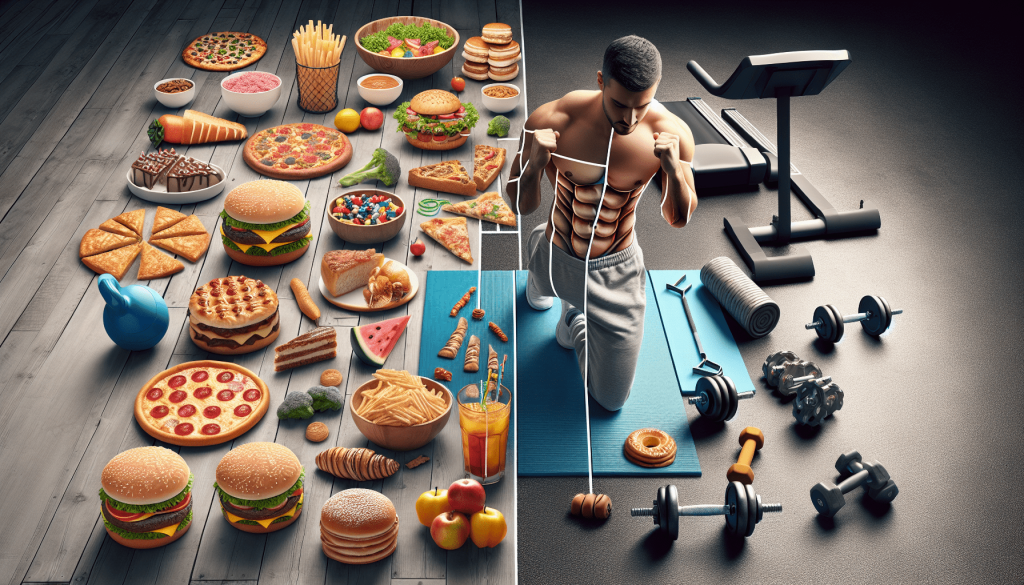Are you determined to achieve that coveted six-pack but find yourself unsure of how to balance your calorie intake with burning calories? Look no further! In this article, we will address the frequently asked question of how to achieve a six-pack by managing your calorie intake and effectively burning calories. By providing you with expert advice and practical tips, we will help you navigate the path towards your fitness goals with confidence and clarity. So, get ready to unlock the secrets to attaining those chiseled abs you’ve always dreamed of!
Understanding Calorie Intake and Burning Calories
In the quest for a six-pack, it is crucial to understand the relationship between calorie intake and burning calories. This article will provide you with comprehensive information on how to find the perfect balance to achieve your fitness goals.
Basics of Calorie Intake and Expenditure
Calories are units of energy that fuel our bodies. We obtain calories through the food and beverages we consume. On the other hand, calorie expenditure refers to the energy we burn through various activities, including exercise and daily bodily functions.
To achieve a six-pack, it is essential to strike a balance between calorie intake and expenditure. If you consume more calories than you burn, you will inevitably gain weight, which can cover up those hard-earned abdominal muscles. Conversely, if you burn more calories than you consume, you will create a calorie deficit and potentially lose fat, revealing those sought-after abs.
Why Balance is Important for a Six-pack
Maintaining a balanced calorie intake is crucial for achieving a six-pack because, ultimately, the visibility of your abdominal muscles is dependent on your body fat percentage. No matter how developed your abs are, they will remain hidden if they are covered by a layer of body fat.
Balancing your calorie intake with calorie burning allows you not only to decrease body fat but also to build and maintain lean muscle mass. By including the right macronutrients and exercising appropriately, you can maximize your chances of revealing a well-defined six-pack.
Calculating Calorie Intake and Expenditure
To strike the right balance, you need to determine your specific calorie needs. This can be achieved by calculating your Basal Metabolic Rate (BMR) and estimating your daily calorie expenditure.
Determining Your Basal Metabolic Rate (BMR)
Your BMR represents the number of calories your body needs at rest to maintain vital bodily functions such as breathing and circulating blood. Several factors, including age, gender, weight, and height, influence your BMR.
To calculate your BMR, you can use a formula such as the Harris-Benedict equation. Once you have your BMR, you can use it as a starting point for your calorie intake calculations.
Estimating Daily Calorie Expenditure
Beyond your BMR, your daily calorie expenditure depends on your activity level. Activities such as exercise, work, and leisure all contribute to the number of calories burned throughout the day. Estimating your daily calorie expenditure can be done by multiplying your BMR by an activity factor that corresponds to your level of activity.
Setting Calorie Intake Goals for a Six-pack
Once you have determined your daily calorie expenditure, you can set your calorie intake goals. To lose fat and achieve a six-pack, creating a calorie deficit is necessary. A safe and sustainable approach is to aim for a calorie deficit of 500-1000 calories per day, which can lead to a weight loss of about 1-2 pounds per week.
However, it is important not to excessively restrict your calorie intake, as this can negatively impact your energy levels, metabolism, and muscle retention. Strive for a gradual, steady weight loss to maintain overall health and preserve your hard-earned muscle mass.

Choosing the Right Macronutrient Ratio
Balanced macronutrient intake plays a crucial role in achieving a six-pack while supporting overall health and well-being. Understanding the importance of protein, carbohydrates, and fat and finding the ideal ratio can significantly contribute to your success.
Importance of Balanced Macronutrient Intake
Protein, carbohydrates, and fat are the three primary macronutrients that provide your body with energy and essential nutrients. Each macronutrient serves its unique purpose in the body, and finding the right balance is key.
Protein is essential for muscle growth, repair, and overall maintenance. It also has a high thermic effect, meaning it requires more energy to digest, making it a valuable asset for fat loss. Carbohydrates provide energy for physical activity and support brain function, while dietary fat contributes to hormone production and nutrient absorption.
Understanding Protein, Carbohydrates, and Fat
The ideal macronutrient ratio for a six-pack will vary depending on individual goals, preferences, and activity levels. However, a general guideline is to consume a moderate to high amount of protein, a moderate amount of carbohydrates, and a moderate amount of healthy fats.
Protein sources can include lean meats, poultry, fish, eggs, dairy products, legumes, and plant-based options such as tofu and tempeh. Complex carbohydrates, such as whole grains, fruits, vegetables, and legumes, should form the majority of your carbohydrate intake. Healthy fats can be obtained from sources like avocados, nuts, seeds, olive oil, and fatty fish.
Finding the Ideal Macronutrient Ratio for a Six-pack
Determining the exact macronutrient ratio that works best for you can involve some trial and error. Consulting with a registered dietitian or nutritionist can provide valuable guidance tailored to your specific needs and preferences. Experimenting with different ratios and tracking your progress can help you find the ideal macronutrient balance that supports fat loss and muscle development.
Eating a Calorie-Controlled Diet
Creating a calorie deficit is essential for losing body fat and revealing a six-pack. However, it is equally important to prioritize nutrient-dense foods and maintain a balanced diet to support overall health.
Creating a Calorie Deficit for Fat Loss
A calorie deficit can be achieved by consuming fewer calories than your body requires. However, it is crucial to approach this deficit mindfully. Drastically reducing calories may lead to muscle loss, decreased energy levels, and nutrient deficiencies. Instead, focus on moderate calorie reduction by making small, sustainable changes to your eating habits.
Emphasize whole, unprocessed foods rich in nutrients, such as fruits, vegetables, lean proteins, and whole grains. Minimize the intake of processed foods, sugary beverages, and high-calorie snacks. Calorie tracking apps and mindful portion control can assist in ensuring you stay within your calorie goals while still enjoying a varied and enjoyable diet.
Monitoring Portion Sizes
Even when consuming nutritious foods, portion sizes play a crucial role in managing calorie intake. Be mindful of your portion sizes and learn to listen to your body’s hunger and fullness cues. Practice mindful eating by slowing down, chewing thoroughly, and savoring each bite.
It can also be helpful to use measuring cups, food scales, or references like the palm of your hand, to gauge appropriate portion sizes. By being aware of portion sizes, you can better control your calorie intake and optimize your chances of a achieving a six-pack.
Including Whole Foods and Nutrient-Dense Choices
Opting for whole foods rather than processed options is not only beneficial for managing calorie intake but also for overall health. Whole foods are typically more nutrient-dense and provide your body with essential vitamins, minerals, and fiber.
Focusing on nutrient-dense choices means prioritizing foods that deliver a high amount of nutrients relative to their calorie content. This can include colorful fruits and vegetables, lean proteins, whole grains, and healthy fats. These choices can fuel your body with the necessary nutrients for optimal performance and support your goal of achieving a six-pack.

Incorporating Exercise for Calorie Burning
While nutrition plays a significant role in achieving a six-pack, incorporating regular exercise is equally important. Exercise helps to increase calorie expenditure, build muscle, and enhance overall fitness levels.
Importance of Exercise for Six-pack Development
Exercise is essential for achieving a six-pack because it aids in fat loss and helps to build and strengthen your abdominal muscles. By combining cardiovascular exercises with strength training, you can maximize calorie burning, improve muscle definition, and promote overall body composition changes.
Types of Cardiovascular Exercises
Cardiovascular exercises, also known as cardio, are a vital component of calorie burning and fat loss. They elevate heart rate, raise metabolism, and increase overall calorie expenditure. Some common cardio exercises include running, cycling, swimming, and aerobic classes.
To make cardio exercises more enjoyable and sustainable, choose activities that you genuinely enjoy. This will increase your adherence and motivation, making it more likely that you will stick with it long term.
High-Intensity Interval Training (HIIT)
High-Intensity Interval Training (HIIT) has gained popularity in recent years due to its efficiency and effectiveness in burning calories. HIIT involves alternating between intense bursts of exercise and short recovery periods. This method can significantly elevate heart rate, improve cardiovascular fitness, and increase overall calorie burning.
Incorporating HIIT workouts into your exercise routine can help to maximize fat loss and promote muscle development. HIIT workouts are versatile and can be adapted to various activities, such as running, cycling, or bodyweight exercises.
Resistance Training and Strength Exercises
Building and strengthening your core muscles is a crucial step towards achieving a well-defined six-pack. Including resistance training and strength exercises can enhance your abdominal muscle development, increase your metabolism, and improve your overall physique.
Exercises such as planks, crunches, Russian twists, and leg raises target the abdominal muscles directly. However, it is important to include full-body resistance training exercises like squats, deadlifts, and push-ups. These exercises engage multiple muscle groups, increase overall calorie burning, and contribute to a balanced physique.
Finding an Effective Training Routine
To make progress towards a six-pack, it is beneficial to follow an effective and balanced training routine. A structured program can guide your exercise selection, volume, and progression, ensuring you make steady progress and avoid plateaus.
Working with a Professional Trainer
If you are new to exercise or unsure how to create an effective training program, working with a certified personal trainer can be highly beneficial. A professional trainer can assess your current fitness level, tailor workouts to your specific goals, and ensure proper form and technique.
By working with a trainer, you will receive guidance and accountability, optimizing your chances of reaching your fitness goals and achieving a six-pack. Whether you choose in-person or online training, the expertise of a professional can make a significant difference in your journey.
Creating a Balanced Exercise Program
A balanced exercise program incorporates a variety of exercises, including cardio, strength training, and core-specific exercises. It is important to include both resistance training and cardiovascular workouts in your routine to maximize calorie burning and promote muscle development.
To prevent overtraining and promote recovery, it is crucial to allow for rest days and incorporate flexibility and mobility exercises. A balanced exercise program ensures that all muscle groups are targeted, promotes overall fitness and prevents muscle imbalances.
Progressive Overload and Adaptive Training
To continue making progress towards your six-pack goal, it is important to challenge your body with progressive overload. This means progressively increasing the intensity, duration, or resistance of your exercises over time.
By gradually increasing the demands placed on your body, you stimulate muscle growth and continuous adaptation. This can be achieved by adding weight to your resistance training exercises, increasing the duration or intensity of your cardio sessions, or progressing to more advanced exercises.
Rest and Recovery
Rest and recovery are vital components of any training program. While it may be tempting to push yourself to the limit every day, overtraining can lead to fatigue, decreased performance, and an increased risk of injury.
Ensure that you incorporate rest days into your training routine to give your body time to repair and rebuild. Adequate sleep, nutrition, and stress management also play crucial roles in promoting recovery and optimizing muscle growth.

Monitoring Progress and Adjusting Caloric Balance
As you embark on your journey towards a six-pack, monitoring your progress is essential to determine whether your current approach is effective or requires adjustments. Consider tracking your body composition and making necessary changes to your calorie intake and expenditure.
Keeping Track of Body Composition Changes
Body composition refers to the proportions of fat, muscle, and other tissues in your body. By monitoring changes in body composition, you can determine the effectiveness of your training and nutrition plan.
Measuring tools such as body fat calipers, bioelectrical impedance scales, or DEXA scans can provide valuable insight into changes in muscle mass and body fat percentage. Periodically taking progress photos and monitoring how your clothes fit can also serve as useful markers of progress.
Measuring Body Fat Percentage
Body fat percentage is a key metric when aiming for a six-pack. To achieve visible abs, men generally need to reduce their body fat percentage to around 10% or lower, while women typically aim for around 18% or lower.
Various methods can be used to measure body fat percentage, including skinfold calipers, bioelectrical impedance, or DEXA scans. These measurements can be taken periodically to track changes and adjust your approach accordingly.
Adapting Caloric Intake for Ongoing Progress
As you make progress towards your six-pack, it may be necessary to adjust your calorie intake. As you lose weight and body fat, your calorie needs will decrease, and a previously effective calorie deficit may become inadequate.
Reassess your calorie intake periodically to ensure it aligns with your current goals and needs. Consulting with a registered dietitian or nutritionist can provide valuable guidance in adjusting your nutritional plan to support ongoing progress and continued fat loss.
Avoiding Common Pitfalls and Mistakes
In your pursuit of a six-pack, it is crucial to avoid common pitfalls and mistakes that can hinder your progress. Falling for restrictive diets, fad diets, and weight loss supplements or ignoring your body’s signals and needs can set you back or even harm your overall health.
Overly Restrictive Diets and Unsustainable Approaches
Extreme or overly restrictive diets may provide short-term results, but they are often unsustainable, leading to feelings of deprivation and potential nutrient deficiencies. These diets can also negatively impact your metabolism, muscle mass, and overall well-being.
Instead of adopting extreme approaches, focus on long-term sustainable changes in your eating habits. Choose nutritious foods, create a moderate calorie deficit, and allow for flexibility and enjoyment within your diet.
Falling for Fad Diets and Weight Loss Supplements
The fitness industry is filled with fad diets and weight loss supplements promising quick and effortless results. However, these approaches often lack scientific evidence and may have potential risks and side effects.
Instead of relying on quick fixes, prioritize a balanced diet, regular exercise, and a healthy lifestyle. Consult with professionals, such as registered dietitians or nutritionists, to receive evidence-based advice tailored to your needs.
Ignoring Your Body’s Signals and Needs
It is essential to listen to your body and pay attention to its signals and needs. Pushing through intense workouts when you are fatigued or ignoring hunger cues can lead to burnout, increased stress, and potential setbacks in achieving your goals.
Respect your body’s need for rest, recovery, and nourishment. Aim for long-term sustainability rather than short-term gains. Be kind to yourself and embrace a well-rounded approach to fitness and health.

Maintaining Long-Term Success and Healthy Habits
Achieving a six-pack is not just about the end goal; it is about adopting healthy habits and maintaining long-term success. Building sustainable lifestyle choices and focusing on overall health rather than just appearance can enhance your overall well-being.
Building Sustainable Lifestyle Choices
Instead of viewing your fitness journey as a temporary fix, focus on building sustainable lifestyle choices. Embrace habits that promote overall health, such as regular physical activity, mindful eating, and stress management.
By adopting a holistic approach to wellness, you will find that the pursuit of a six-pack becomes an enjoyable part of a balanced and fulfilling lifestyle.
Staying Consistent with Nutrition and Exercise
Achieving a six-pack requires consistency in both nutrition and exercise. Consistently following a balanced diet and adhering to a regular exercise routine will yield long-term results and help you maintain your desired physique.
Establish a routine that works for you and prioritize self-discipline and commitment. When faced with challenges or setbacks, remind yourself of your goals and stay motivated to continue your journey.
Focusing on Overall Health, Not Just Six-pack Abs
While having a six-pack can be a desirable goal, it is important to recognize that a healthy lifestyle encompasses more than just physical appearance. Focus on overall health improvements, such as increased strength, cardiovascular fitness, and mental well-being.
Shift your mindset from solely seeking a six-pack to valuing the positive changes you are making in all aspects of your life. Celebrate the progress you have made and embrace the holistic benefits of a healthy lifestyle.
Seeking Professional Guidance
Achieving a six-pack involves various factors and can be a complex endeavor. Seeking professional guidance from registered dietitians and certified personal trainers can provide personalized advice and increase your chances of success.
Consulting a Registered Dietitian
Registered dietitians specialize in nutrition and can provide expert guidance on creating a tailored eating plan to support your goals. They can assess your individual needs, preferences, and any underlying health conditions to help you develop a sustainable nutrition strategy.
Working with a registered dietitian ensures that you receive evidence-based advice, appropriate guidance for macronutrient ratios, and support in managing your caloric intake for optimal fat loss and muscle development.
Working with a Certified Personal Trainer
Certified personal trainers have the expertise to design a safe and effective exercise program that is specific to your goals. They can help you with proper form and technique, provide accountability, and motivate you to push beyond your limits.
A personal trainer can tailor workouts to target your abdominal muscles, increase overall calorie expenditure, and guide you through progressive overload and periodization. Their expertise ensures that you remain on track toward achieving your six-pack goals while minimizing the risk of injury.
Considering Individualized Programs and Expert Advice
Individualized programs and expert advice can provide you with personalized insights and strategies to reach your desired results. Online platforms, such as customized workout apps or nutritional coaching services, can offer comprehensive plans tailored to your specific needs.
By working with professionals who specialize in your desired outcomes, you can maximize your chances of success and receive the support you need throughout your journey.
In conclusion, achieving a six-pack involves finding the right balance between calorie intake and burning calories. By understanding the basics of calorie intake and expenditure, calculating your calorie needs, choosing the right macronutrient ratios, and engaging in a calorie-controlled diet and exercise routine, you can make consistent progress towards your goal. It is important to monitor your progress, avoid common pitfalls, and focus on long-term success and overall health. Seeking professional guidance can provide valuable insights and personalized advice to enhance your chances of achieving a six-pack and maintaining a healthy lifestyle.






